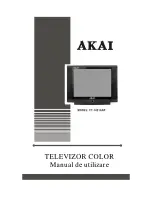
Use this receiver with your Airtronics RDS8000 2.4GHz transmitter or your Airtronics SD-10G 2.4GHz transmitter. Due to differences in
the implementation of 2.4GHz technology among different manufacturers, this receiver is compatible only with Airtronics 2.4GHz aircraft transmitters.
Receiver Operating Instructions
Model: 92674
Frequency: 2.4GHz FHSS-1
Input Voltage: 4.8v - 6.0v
Weight: .31oz (8.8gr) with Case
Weight: .24oz (6.9gr) without Case
Dimensions: 1.80 x 0.85 x 0.47in (45.7 x 21.5 x 12mm)
Fail Safe Support: Yes (CH 1~CH 4)
2.4GHz Frequency Band Precautions
This receiver operates on the 2.4GHz frequency band. The 2.4GHz connection is determined by the transmitter and receiver pair.
Unlike ordinary crystal-based systems, your model can be used without frequency control.
7-Channel Full-Range
Bind Button
Coaxial Cables
Antenna
Reception
Wires
Bind LED
CH 7 Aux / Batt
CH 6 Flap
CH 5 Gear
CH 4 Rudder
CH 3 Throttle
CH 2 Aileron
CH1 Elevator
l
The 2.4GHz frequency band may be used by other devices, or other devices in the immediate area may cause interference on the
same frequency band. Always before use, conduct a bench test to ensure that the servos operate properly. Also, conduct a range
test at the area of operation to ensure that the radio control system has complete control of the model at the farthest reaches of the
operational area.
l
The response speed of the receiver can be affected if used where multiple 2.4GHz radio control systems are being used, therefore,
carefully check the area before use. Also, if response seems slow during use, discontinue use as quickly as possible.
l
If the 2.4GHz frequency band is saturated (too many radio controllers on at once), as a safety precaution, the radio control system
may not bind. This ensures that your radio control system does not get hit by interference. Once the frequencies have been cleared,
or the saturation level has dropped, your radio control system should be able to bind without any problems.
l
Observe any applicable laws and regulations in place at your flying site when using the 2.4GHz radio control system.
l
Unlike frequency bands used with earlier radio control systems, reception with this 2.4GHz radio control system can be adversely
affected by large obstructions and concrete or steel structures between your model and the transmitter. Also, wire mesh and similar
barriers can adversely affect operation. Keep this mind to ensure the safety of your model.
*Negative Pin is Toward the Bottom of the Receiver.
N / P / S
l
The receiver antenna wires consists of two coaxial cables and two reception wires (the thin tip at the end of the coaxial cables). When
you mount the receiver antenna wires, do not bend the reception wires. Reception performance decreases if the reception wires are bent.
l
The receiver antenna wires are delicate, therefore, handle with care. Do not pull on the receiver antenna wires with force. Do not cut
or extend the receiver antenna wires.
l
The coaxial cables (the thicker portion of the receiver antenna wires) can be bent into gentle curves, however, do not bend the coaxial
cables acutely, or repeatedly bend them, or the antenna cores can be damaged.
l
When installed in an electric-powered model, keep the receiver antenna wires as far away from the motor, battery, and electronic
speed control (ESC) as possible.
l
There is a danger of runaway operation if connectors shake loose during use. Make sure that the receiver, servo(s), and switch harness
connectors are securely fitted.
l
The receiver is susceptible to vibration and moisture. Take appropriate measures to protect against vibration and moisture. The
receiver should be wrapped in foam and the foam should be secured around the receiver to hold it in place. The foam should not be
secured too tightly or the vibration dampening quality will be reduced. Failure to take appropriate measures could result in damage to
the receiver.
l
When installing the receiver, the antenna reception wires (the thin tip at the end of the coaxial cables) should not come into contact
with any carbon or metal components (conductive components). Aircraft fuselages and helicopter frames may contain conductive
components. If mounting the receiver surrounded by conductive materials (for example, a carbon fiber fuselage), mount the receiver
so that the antenna reception wires can be extended outside of the model. Reception can be blocked if the antenna reception wires
are shielded inside a carbon fiber fuselage.
It is extremely important to install the receiver and route the receiver antenna wires correctly in your model. This will ensure
that your model receives control signals no matter what its posture, attitude, or heading. For more information, see page 3.
receiver Precautions
1
RX-700
2.4GHz FHSS-1
92674
N=Negative / P=Postive / S=Signal






















